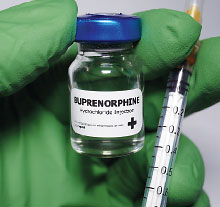Possible PTSD Subtype Identified
Using neuroimaging, a team led by researchers at Stanford University has identified a potential subtype of posttraumatic stress disorder (PTSD) with unique patterns of brain activity and a poor response to psychotherapy.
The findings, published in Science Translational Medicine, provide new insight into the heterogeneity of PTSD.
The researchers evaluated patients from two separate studies that comprised 184 people with PTSD and 153 controls. They identified a subgroup of people with PTSD in each study cohort that displayed poor verbal memory skills and abnormal neuron connectivity in their ventral attention network—a neural network that regulates attention to stimuli. This subgroup was like the rest of the PTSD group in terms of symptoms and comorbidities, but they showed a poor response to psychotherapy.
Interestingly, people with either abnormalities in the ventral attention network or poor verbal memory showed a good response to psychotherapy. This suggests that these two impairments are likely independent but related traits that reflect an underlying core deficit in information processing, the authors wrote.
The authors noted that the two study groups were quite different: One consisted primarily of female civilians experiencing PTSD from sexual trauma, and the other involved male veterans with combat-related trauma. The occurrence of similar neurological abnormalities in both groups suggests these findings might generalize to all patients with PTSD, they said.
Concurrent Use of Medications for OUD May Not Inhibit Ketamine
Some studies suggest that ketamine may work in large part by activating mu opioid receptors (MORs). If true, ketamine might prove less effective in patients taking other medications that modulate MORs, such as naltrexone, buprenorphine, and methadone.
A retrospective analysis of 40 veterans who received ketamine for treatment-resistant depression now suggests that taking one of these medications concurrently with ketamine does not attenuate ketamine’s effects.
The study involved 40 patients who were treated at the San Francisco VA Medical Center for treatment-resistant depression with six infusions of ketamine over three weeks. This group included eight patients on stable doses of MOR medications (five on buprenorphine, two on methadone, and one on naltrexone). These eight patients demonstrated the same improvements in their Beck Depression Inventory scores as the 27 patients not on any opioid medications for opioid use disorder. Six patients with active psychosis or substance use disorder were excluded from the final analysis.
The authors noted these findings differ from a recent study that found acute naltrexone administration can reduce ketamine efficacy. “These divergent results may be explained by differences in ketamine’s activity in the setting of long-term versus immediate opioid administration,” they wrote. “For example, long-term administration of MOR agonists can lead to changes in MOR expression (leading to tolerance).”
This study was conducted by researchers at the University of California, San Francisco, and published in Biological Psychiatry.
Debt Relief Reduces Anxiety, Improves Thinking
Debt relief may improve cognition and reduce anxiety in low-income individuals, according to a study in PNAS.
Researchers at the National University of Singapore and Singapore University of Social Sciences enrolled 196 individuals with chronic debt (debts owed for at least six months) who had just received one-time, debt-relief from a local charity. The relief provided up to the equivalent of 5,000 Singaporean dollars (three month’s household income) based on the amount of debt. The participants underwent cognitive and psychological functioning tests when they received the debt relief and again three months later.
The researchers found that three months post-relief, the participants made fewer mistakes on a common cognitive test known as the Eriksen flanker test. In addition, the number of people exhibiting anxiety disorder symptoms fell from 78% to 53%.
Participants who used their debt relief to reduce the total number of debt accounts reported better improvements on average compared with those who used the money to partially reduce all debts. This suggests that reducing the “mental accounting” that arises from dealing with multiple creditors by restructuring contributes to the psychological improvements of debt-relief, according to the study authors.
Depression Symptoms May Differ Based on Exposure to Other Illnesses, Stressors
Both social stressors and medical illnesses are known to be risk factors for depression, but there has been little research into which specific symptoms they may affect. Using data from the U.S. National Health and Nutrition Examination Surveys (NHANES), researchers from the University of Helsinki and colleagues report that comorbid illnesses are risk factors for somatic symptoms, while social stressors are associated with cognitive symptoms.
The findings were published in the Journal of Affective Disorders.
Overall, NHANES participants who reported one or more chronic illnesses also reported higher levels of fatigue, moving/speaking too slowly or too fast, and sleep problems. The associations were dose dependent; for example, people with one, two, three, or more chronic illnesses had 1.24, 1.61, and 2.59 increased odds of fatigue, respectively. Comorbid illness also increased the odds of sad mood, but other cognitive or affective symptoms were not affected.
In contrast, social risk factors, including divorce, poverty, or perceived lack of emotional support, were more closely associated with cognitive/affective symptoms. Divorced individuals had higher levels of anhedonia, sad mood, worthlessness, suicidal thoughts, and sleep problems but lower levels of fatigue. Poverty was related to higher levels of anhedonia, sad mood, suicidal thoughts, and movement/speaking problems. Perceived lack of support was associated with anhedonia, sad mood, worthlessness, and poor appetite.
Study Quantifies Lifetime Risk of Cancer Based on Alcohol Use
Like smoking, chronic alcohol consumption increases cancer risk, though this risk is less publicly well-known. To help increase awareness, a team led by researchers at the University of Southampton set out to quantify and contextualize the risk of cancer from alcohol consumption.
As reported in BMC Public Health, the researchers found that drinking one bottle of wine per week increases the lifetime risk of cancer by 1.0% in men and by 1.4% in women. The increased risk of cancer from alcohol is similar to smoking five cigarettes per week in men and 10 per week in women.
Consuming three bottles of wine per week increased cancer risks by 1.9% in men and 3.6% in women. The researchers noted that the higher rates of cancer in women are due to a strong association between alcohol consumption and breast cancer.
The researchers used population data available from Cancer Research UK along with previous reports that estimated cancer diagnoses attributable to tobacco and alcohol use to calculate these risk levels.
“We must first be absolutely clear that this study is not saying that drinking alcohol in moderation is in any way equivalent to smoking,” the researchers wrote. “Smoking kills up to two-thirds of its users, and cancer is just one of the many serious health consequences. This study purely addresses cancer risk in isolation.” ■





